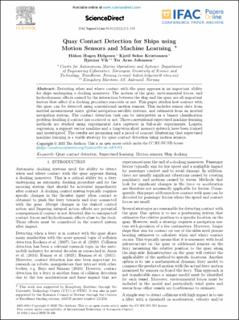| dc.contributor.author | Helgesen, Håkon Hagen | |
| dc.contributor.author | Kristiansen, K S | |
| dc.contributor.author | Vik, Bjørnar | |
| dc.contributor.author | Johansen, Tor Arne | |
| dc.date.accessioned | 2023-02-17T13:38:38Z | |
| dc.date.available | 2023-02-17T13:38:38Z | |
| dc.date.created | 2022-12-21T06:25:51Z | |
| dc.date.issued | 2022 | |
| dc.identifier.issn | 2405-8963 | |
| dc.identifier.uri | https://hdl.handle.net/11250/3052007 | |
| dc.description.abstract | Detecting when and where contact with the quay appears is an important ability for ships undergoing a docking maneuver. The motion of the quay, environmental forces, and hydrodynamic effects caused by the interaction between the ship and the quay are all important factors that affect if a docking procedure succeeds or not. This paper studies how contact with the quay can be detected using conventional motion sensors. This includes sensor data from inertial measurement units, global navigation satellite systems, and estimates from an inertial navigation system. The contact detection task can be interpreted as a binary classification problem deciding if contact has occurred or not. Three conventional supervised machine learning methods are studied using experimental data captured in full-scale experiments. Logistic regression, a support vector machine and a long-term short memory network have been trained and investigated. The results are promising and a proof of concept illustrating that supervised machine learning is a viable strategy for quay contact detection using motion sensors. | en_US |
| dc.language.iso | eng | en_US |
| dc.publisher | IFAC | en_US |
| dc.rights | Attribution-NonCommercial-NoDerivatives 4.0 Internasjonal | * |
| dc.rights.uri | http://creativecommons.org/licenses/by-nc-nd/4.0/deed.no | * |
| dc.title | Quay Contact Detection for Ships using Motion Sensors and Machine Learning | en_US |
| dc.title.alternative | Detection of Contact with Quay for Ships using Motion Sensors and Machine Learning | en_US |
| dc.type | Peer reviewed | en_US |
| dc.type | Journal article | en_US |
| dc.description.version | publishedVersion | en_US |
| dc.source.journal | IFAC-PapersOnLine | en_US |
| dc.identifier.doi | 10.1016/j.ifacol.2022.10.448 | |
| dc.identifier.cristin | 2096049 | |
| dc.relation.project | Norges forskningsråd: 223254 | en_US |
| cristin.ispublished | true | |
| cristin.fulltext | postprint | |
| cristin.qualitycode | 1 | |

